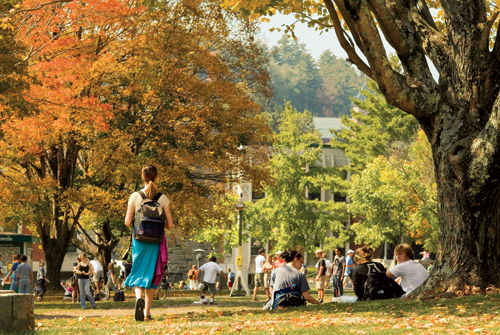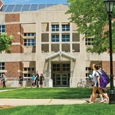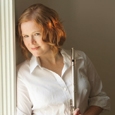
Ask any serious high school or college flute student today, “What are you going to major in college?” Overwhelmingly the answer is music performance. Then when you ask, “What are you going to do with this degree,” the answer is to perform in a symphony orchestra or teach at a university. In the past few years there have been very few openings in the orchestral field and even fewer in academic employment.
Full-Time
At most universities a full-time teaching load consists of 18 one-hour flute lessons, plus other courses including flute choir, chamber music coaching, woodwind methods, and performing in a faculty woodwind quintet. Non-musical duties include faculty meetings, committee work, and recruitment. If a flute studio load is less than 18 hours of flute lessons, extra courses such as music appreciation or music theory may be added to the professor’s schedule.
Most teachers are hired at the assistant professor level and work on a probationary basis for 3 to 7 years before being promoted to the rank of associate professor with tenure. Depending on previous professional experience, some flutists may enter at the associate or full professor level. Each university has its own path to a full professorship.
Lecturer or instructor positions are typically full-time, but not tenure-track. In some situations, a doctoral degree is not required for a non-tenure position, but all others require a terminal degree or equivalent work experience. According to the College Music Society, the followeing were average faculty salaries in 2011-2012 based on 9 or 10-month contracts. (As a side note, salaries for visual and performing arts are the second lowest in the field of higher education.)
Instructor $44,002
Assistant Professor $52,835
Associate Professor $63,372
Full Professor $81,257
Other benefits to full-time university positions include health insurance, a retirement plan, and sometimes a parking spot close to the music building. If you think this sounds perfect, keep in mind that college teaching can be a grueling lifestyle with many evening and weekend commitments. Even after students graduate, professors often continue to help them with recommendation letters and supportive calls and emails. While the number of flutists with a doctoral degree rises every year, there are only 1,122 college flute teachers in the United States.
Part-Time
Due to funding concerns, part-time or adjunct work has become a popular option for universities because these positions do not include health benefits, retirement plans, and moving reimbursement. The adjunct workload is similar to that of a full-time professor. These responsibilities include teaching flute lessons, coaching flute ensemble, and sometimes classes in music theory, music appreciation, or woodwind methods. Usually adjunct professors are not required to attend faculty meetings or serve on academic committees.
The educational requirement for an adjunct position is usually a master’s degree in music; however, it is becoming more common that applicants with doctorates or ABD (all but the dissertation) status are winning these positions. Adjunct teaching can provide valuable work experience to help a flutist progress to full-time teaching. Since part-time faculty usually work only a few days a week, several adjunct professors may share the same office space.
Adjunct professors usually are paid on an a la carte system. This means they are paid per student and also per course. In actuality the adjunct will be paid about one-third the salary of a full-time assistant professor. For example, at the University of Tennessee at Chattanooga, an adjunct professor teaching a 3-credit music appreciation course meeting 45 hours per semester is paid around $2000.
It is a misconception that developing the flute studio to 18 students will turn the part-time teaching position into a full-time contract. The university gives the music department a set number of tenure or full-time teaching contracts. However, due to the large number of teachers and variety of courses offered within the curriculum, music departments favor the adjunct model. Another hurdle for part-time adjuncts is the Affordable Care Act, which goes into effect January 2014. In response, universities are cutting adjunct hours to avoid having to provide health insurance.
If you look past these bleak statistics, many adjunct professors are highly satisfied with their positions. For the recent graduate, an adjunct position offers teaching opportunities to build a resume. For others, teaching part time may be the perfect complement to raising children and performing professionally. Since the tenure process is not required, adjunct teachers can simply enjoy teaching.
.jpg)
For a better understanding of life as a college teacher, five flute professors answer questions and share their insights.
Describe your teaching position.
Jennifer Amox: I currently teach at a small 4-year liberal arts state university in the south. I teach 2 flute performance majors, 11 music education majors and 3 flute minors, in addition to a 1-credit hour flute choir. At my university this constitutes an 11 and 1/3 credit hour teaching load. In addition, I generally teach a Humanities class every summer. (I have asked to teach additional music history or theory classes in the future.)
Mary Karen Clardy: I am Regents Professor at The University of North Texas. My teaching load consists of undergraduate and graduate applied lessons, a weekly studio class, and chamber music coaching. I joined the faculty as an assistant professor in 1980.
Tereasa Payne: Until recently, I taught as an adjunct professor at two universities: Bethune-Cookman University and Daytona State College. I taught flute lessons, flute choir, and woodwind quintets at both schools. In the past I have also taught clarinet and saxophone at both schools. I typically had 5-8 flute majors at BCU and anywhere from 1-10 students at DSC.
Diane Boyd Schultz: I am the flute professor at The University of Alabama, the flagship institution of the state, which is located in Tuscaloosa. Eighteen flute majors is considered to be a full load; however, I also coach flute choir and other woodwind ensembles, teach the flute portion of the methods course for music education majors, and teach graduate courses in flute pedagogy and other special topics. I began in the fall of 2005.
Patricia Surman: Five years ago, I began as an adjunct professor at Northeastern State University in Tahlequah, Oklahoma. This year I return as a full-time professor (non-tenure track). In addition to applied lessons, I have taught chamber music, music appreciation, rock music history, and courses in the music theory sequence. Previously I served as an adjunct professor at Southwestern Oklahoma State University, Southwestern Adventist University, and Tulsa Community College.
What are some benefits and rewards of teaching at a college or university?
Amox: When I was initially hired, I held a full-time position teaching band at the secondary level. I could easily teach one night per week at the university and continue my day job. It was the perfect combination of “what I wanted to do” (teach applied flute) and “what I needed to do” (hold a salaried position with benefits). As the studio grew, it became difficult to juggle both, and I eventually returned to graduate school to obtain my doctorate. My university was incredibly supportive and allowed me to work around my class schedule. I am able to enjoy teaching and performing without the added stress of required committee work or additional duties while I am writing my dissertation.
Mary Karen Clardy: Developing artistic, musical and technical autonomy is the primary goal of my teaching. My job is accomplished when a student’s growth reaches a level of confidence and maturity to demonstrate the capacity for creative thinking and problem solving with new repertoire, musical phrasing, and technical challenges. One of my greatest joys as a teacher is welcoming former students as colleagues and then serving as a mentor to guide them through an orchestral or academic career.
The teaching process is also rewarding because I constantly learn from my students. Solving common problems in new, creative ways adds an element of excitement to learning, and I often find the solution carries through in my own practice. Observing a class of students develop and grow is exciting.
Payne: I love teaching adjunct because the schedule can be adjusted to suit my touring schedule. Both schools are very accommodating and let me set my schedule as needed. I also am permitted to teach students via Skype when I am on the road for an extended period of time.
Schultz: With over 33,000 students and a variety of programs, the university offers all sorts of cultural, educational, and athletic events to the campus and surrounding community. Students and faculty come from all over the United States and abroad.
Surman: I enjoy guiding my students, so they can realize their inherent potential. Seeing them achieve their own goals through intelligent practice is the most personally and professionally fulfilling experience that I could imagine. I feel honored to be able to teach a set of core values through music. These include self-esteem, hard work, service, goal setting, etc. We all know how incredibly joyous and challenging it is to play the flute. For me, teaching young adults how to create their own career with the flute is rewarding beyond measure.
What challenges do you face at your school?
Amox: Until this year, I shared an office with five other adjunct teachers. Scheduling make-up lessons was terribly difficult. We were always accidentally walking in on each others’ lessons. There also was no storage for sheet music or files. This year I finally have my own office, which will reduce the stress.
I teach three days a week, so that I can attend school in a neighboring state the other two days. There are no lunch breaks or time to practice during the day. (I teach 5-7 hours straight with no breaks.) At times, this can become taxing and I have to plan my meals and practice accordingly.
As an adjunct teacher, I cannot function as my students’ academic adviser. This is inconvenient at times, as I do assist them with their course planning, but must send them to someone else to submit their schedules. The biggest problem with adjunct teaching is the lack of benefits. My institution does not offer health insurance to adjuncts, even if an offer to pay the entire premium is made. I also cannot contribute to a retirement plan through the university. I am paid on a per-course basis and will barely make above poverty level this year. (Thankfully, I have other income sources.)
This is an ideal situation since I am in school; however, I am not certain I could maintain it long-term. The conundrum of adjunct teaching is finding the balance of growing a studio while still maintaining a schedule flexible enough to work around additional employment. Even with a full-time load, I cannot support myself financially merely on my adjunct income. I have to design a schedule that allows me to hold an additional job.
Payne: It is difficult to feel like an integral member of the music faculty when you are adjunct. Both the department chair and I have to work hard to make sure that we are communicating about changes, needs, and students’ progress. Often, I come in to teach for the day and never have contact with any of the other faculty. I appreciate when I am included in emails and memos that are circulated between the full-time faculty regarding the school of music and its students. As an adjunct faculty member, we have to work hard to not be a “check-in and check-out” teacher; but to truly be a member of the music faculty circle.
Schultz: Enrollment is increasing in the school of music as well as university-wide, which places a strain on our physical spaces. While the Moody Music building has some wonderful features, we are now expanding into some facilities on the opposite edge of campus. Like most institutions of higher education, there are fiscal challenges, particularly as we work to modernize our facilities and academic programs, and students face escalating tuition costs.
Surman: It is a challenge to meet the needs of a diverse flute studio; my students are pursuing a wide variety of goals from music education to performance, music therapy, and music entrepreneurship.
What advice would you give to current music majors or high school flutists considering a career in college teaching?
Amox: To gain experience, I suggest developing a large private studio while you are in school. This will teach you how to plan recitals and events, in addition to scheduling lessons and handling finances. Be flexible with career plans and willing to take whatever employment you can find as you piece together enough to be financially secure. Accept an adjunct position even if you are only offered one student or one class to teach. It is quite possible that your load will increase as you display your enthusiasm and work ethic.
Clardy: My advice is to begin teaching as soon as possible to gain experience, build a resume, and expand future career options.
Payne: I think adjunct teaching is underrated, even though I do not get benefits. The hours are flexible, the variety is exciting, and there are many students who truly value a great instructor at a smaller school. I have a very close relationship to my students that continues throughout their careers and lives.
Schultz: Find the best teacher and college or conservatory you can. Then practice, practice, practice. Seek a variety of avenues for performance, study scores, and make listening a habitual part of your musical routine. Since most institutions require MM and DMA degrees, be prepared for several more years of training. Those programs usually are demanding both musically and academically. Find ways to improve your teaching by working with local music organizations, observe great teachers while they teach, read those wonderful flute pedagogy books that are available, and use technology to strengthen both your teaching and performing. Create a high-quality professional portfolio that includes a CV, teaching philosophy, a recording of your playing, a video recording of your teaching, a reference list, and a repertoire list. Different schools ask for different things in the audition and interview process. Be ready when the opportunity arises. It takes many hours of hard work and dedication to be successful in the field, and college professors of music often work days, nights, and weekends.
Surman: Develop musicianship skills, both technically and artistically. Gain as much orchestral, chamber music, and solo experience as possible, and work with a teacher who will mentor you not only as a performer, but also as a future educator. Get involved with organizations such as the National Flute Association, College Music Society, MTNA, and local flute clubs and build relationships with others in the music community. Always be professional and learn how to be teachable. Consider learning a subspecialty within the field of music that will enhance your teaching and research portfolio. Most importantly, commit yourself fully to your dreams.
Diane Boyd Schultz is the flute professor at the University of Alabama, principal flutist of the Tuscaloosa Symphony, and flutist with the Capstone Quintet. She is a reviewer of new flute music for Flute Talk.
Mary Karen Clardy, the Regents Professor of flute at The University of North Texas, appears as a soloist and chamber artist. She records for the EPR label and is published by Leduc, Schott, and Universal Edition. She is a Consulting Editor of Flute Talk. www.mkclardy.com
Tereasa Payne – Flutist/Ethnic Flutist/Woodwind Doubler – performs throughout the US with orchestras, artists, and Broadway shows (in NYC and on tour) and can be seen in the pit orchestra on the NBC series, SMASH. Tereasa is a founding member of the Areté Woodwind Doubling Quartet, premiering works for multiple woodwinds. www.tereasapayne.com
Heather Small has performed at the NFA Conventions in Kansas City (2008), Charlotte (2011), and Las Vegas (2012). She is currently on faculty at the University of Tennessee Chattanooga and Southern Adventist University, and is the high school soloist competition coordinator for the Mid-South Flute Society. www.smallflute.com
Fulbright Scholar Dr. Patricia Surman is Artist Teacher of Flute at Northeastern State University. In demand as a soloist, Patricia has recently performed in Taiwan, Korea, Canada, France, and Spain and has played solo recitals and taught masterclasses across the United States. www.patriciasurman.com






